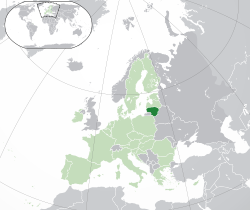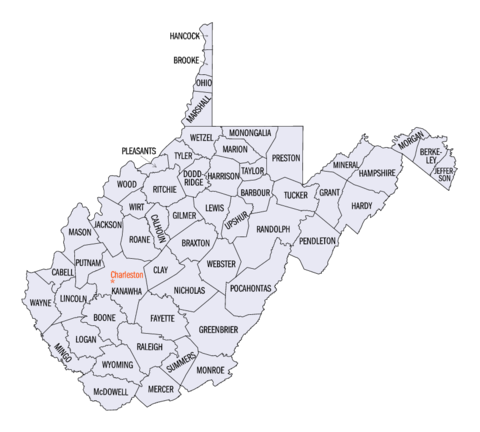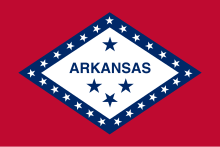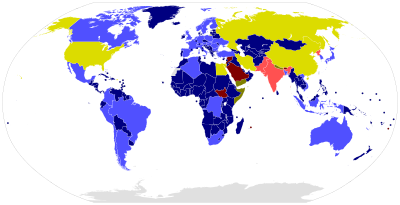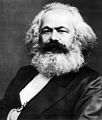
Back Portal:Politik ALS بوابة:السياسة Arabic بوابة:سياسة ARZ Портал:Политика Bulgarian প্রবেশদ্বার:রাজনীতি Bengali/Bangla Portal:Politika BS دەروازە:سیاسەت CKB Portál:Politika Czech Portal:Politik German Portal:Siyaset DIQ
| Main | Topics and categories | Tasks and projects |
The Politics portal
Politics (from Ancient Greek πολιτικά (politiká) 'affairs of the cities') is the set of activities that are associated with making decisions in groups, or other forms of power relations among individuals, such as the distribution of resources or status. The branch of social science that studies politics and government is referred to as political science.
It may be used positively in the context of a "political solution" which is compromising and non-violent, or descriptively as "the art or science of government", but also often carries a negative connotation. The concept has been defined in various ways, and different approaches have fundamentally differing views on whether it should be used extensively or in a limited way, empirically or normatively, and on whether conflict or co-operation is more essential to it.
A variety of methods are deployed in politics, which include promoting one's own political views among people, negotiation with other political subjects, making laws, and exercising internal and external force, including warfare against adversaries. Politics is exercised on a wide range of social levels, from clans and tribes of traditional societies, through modern local governments, companies and institutions up to sovereign states, to the international level.
In modern nation states, people often form political parties to represent their ideas. Members of a party often agree to take the same position on many issues and agree to support the same changes to law and the same leaders. An election is usually a competition between different parties.
A political system is a framework which defines acceptable political methods within a society. The history of political thought can be traced back to early antiquity, with seminal works such as Plato's Republic, Aristotle's Politics, Confucius's political manuscripts and Chanakya's Arthashastra. (Full article...)
Selected article
Feminism is a collection of movements and ideologies aimed at defining, establishing, and defending equal political, economic, and social rights for women. In addition, feminism seeks to establish equal opportunities for women in education and employment. A Feminist is "an advocate or supporter of the rights and equality of women". Feminist theory, which emerged from these feminist movements, aims to understand the nature of gender inequality by examining women's social roles and lived experience; it has developed theories in a variety of disciplines in order to respond to issues such as the social construction of sex and gender. Some of the earlier forms of feminism have been criticized for taking into account only white, middle-class, educated perspectives. This led to the creation of ethnically specific or multiculturalist forms of feminism. Feminist activists campaign for women's rights – such as in contract law, property, and voting – while also promoting bodily integrity, autonomy, and reproductive rights for women. Feminist campaigns have changed societies, particularly in the West, by achieving women's suffrage, gender neutrality in English, equal pay for women, reproductive rights for women (including access to contraceptives and abortion), and the right to enter into contracts and own property. Feminists have worked to protect women and girls from domestic violence, sexual harassment, and sexual assault. They have also advocated for workplace rights, including maternity leave, and against forms of discrimination against women. Feminism is mainly focused on women's issues, but because feminism seeks gender equality, some feminists argue that men's liberation is a necessary part of feminism, and that men are also harmed by sexism and gender roles.
Featured picture

George John Douglas Campbell, 8th Duke of Argyll KG, KT, PC, FRS, FRSE (30 April 1823 – 24 April 1900), styled Marquess of Lorne until 1847, was a Scottish peer, Liberal politician as well as a writer on science, religion, and the politics of the 19th century.
The majority of New Hampshire's counties were named for prominent British or American people or geographic locations and features. Only one county's name originates in a Native American language: Coös County, named for an Algonquian word meaning "small pines". (Full article...)
The longest-serving current first minister is Prime Minister Justin Trudeau, who assumed office on November 4, 2015; the newest first minister is R.J. Simpson of the Northwest Territories, who assumed office on December 8, 2023. The oldest first minister, Blaine Higgs of New Brunswick, is 70; the youngest first minister, P.J. Akeeagok of Nunavut, is 39. Of the current first ministers, one (Danielle Smith of Alberta) is a woman and three (P.J. Akeeagok of Nunavut, Wab Kinew of Manitoba, and R.J. Simpson of the Northwest Territories) are Indigenous. (Full article...)
Following Joseph Stalin's consolidation of power in the 1920s, the post of the general secretary of the Central Committee of the Communist Party became synonymous with leader of the Soviet Union, because the post controlled both the Communist Party and the Soviet government both indirectly via party membership and via the tradition of a single person holding two highest posts in the party and in the government. The post of the general secretary was effectively abolished in 1934 under Stalin, though it technically continued in existence until 1952, and was later re-established by Nikita Khrushchev under the name of the first secretary. In 1966, Leonid Brezhnev reverted the office title to its former name. Being the leader of the Communist Party of the Soviet Union, the office of the general secretary was the highest in the Soviet Union until 1990. The post of general secretary lacked clear guidelines of succession, so after the death or removal of a Soviet leader the successor usually needed the support of the Political Bureau (Politburo), the Central Committee, or another government or party apparatus to both take and stay in power. The President of the Soviet Union, an office created in March 1990, replaced the general secretary as the highest Soviet political office. (Full article...)
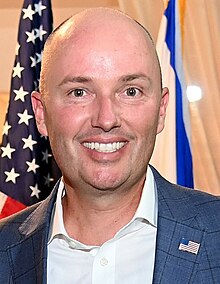
The governor of Utah is the head of government of Utah and the commander-in-chief of its military forces. The governor has a duty to enforce state laws as well as the power to either approve or veto bills passed by the Utah Legislature. The governor may also convene the legislature on "extraordinary occasions".
The self-proclaimed State of Deseret, precursor to the organization of the Utah Territory, had only one governor, Brigham Young. Utah Territory had 15 territorial governors from its organization in 1850 until the formation of the state of Utah in 1896, appointed by the President of the United States. John W. Dawson had the shortest term of only three weeks and Brigham Young, the first territorial governor, had the longest term at seven years. (Full article...)
Selected quote
Selected biography
Phạm Ngọc Thảo (1922–1965), a major provincial leader in South Vietnam and infiltrator of the Army of the Republic of Vietnam (ARVN), was a communist agent of the Viet Minh and later the Vietnam People's Army. As the overseer of Ngô Đình Nhu's Strategic Hamlet Program in the early 1960s, he deliberately forced the program forward at unsustainable speeds, constructing poorly equipped and poorly defended villages, in order to foster rural resentment against the regime of President Ngo Dinh Diem, Nhu's elder brother. Thao was posthumously promoted by the ARVN to the rank of one-star general and awarded the title of Heroic war dead (Vietnamese: Liệt sĩ). After the Fall of Saigon and the end of the Vietnam War, the communist government awarded him the same title and paid war pensions to his family, claiming him as one of their own.
Did you know (auto-generated) -

- ... that Patricia Grace did not intend for her novel Potiki, about the impact of land development on an indigenous community, to be seen as political?
- ... that following the Russian invasion of Ukraine, a diverse group of exiled Russian public figures formed the Anti-War Committee of Russia to unite different political movements to oppose the war?
- ... that Disney once created a political advertisement for Dwight D. Eisenhower (featured)?
- ... that in the 1916 Declaration of Sainte-Adresse Britain, France and Russia committed to securing the political and economic independence of Belgium after the First World War?
- ... that following the ban of its labour unions in 1934, the Romanian United Socialist Party would rely on its youth and women's wings for political action?
- ... that in 1850s New Orleans, the French revolutionary Joseph Déjacque called for black slaves and the white working class to overthrow the United States in a social revolution?
More did you know...
- ...that Thutmose I was the first Pharaoh to be buried in the Valley of the Kings?
- ...that Mussolini's Quota 90 fixed the lira exchange rate against the pound sterling at the prevailing rate from five years earlier, when he assumed power?
- ...that the energy lobby contributed 19 million dollars to United States political campaigns in the 2006 election cycle?
- ...that the lifelong Democrat Jim Naugle is in his sixth straight term as the Mayor of Fort Lauderdale and supported only Republicans for President since 1968?
- ...that the Brown Dog affair, an Edwardian era vivisection controversy, led to massive riots?
- ...that in April 2009, Lim Hwee Hua became the first woman to be appointed a full Minister in Singapore's Cabinet?
In this month
- May 5, 2005 – A General Election in the United Kingdom sees Tony Blair's Labour government returned to office with a reduced majority of 66.
- May 14, 1948 – The Declaration of Independence of Israel is made.
- May 18, 1948 – The first Legislative Yuan of the Republic of China officially convenes in Nanking.
News and Current events
- August 11: 4 local government areas in New South Wales, Australia locked down after COVID-19 case
- August 11: Australia: AstraZeneca vaccine access expanded by Victorian government
- August 1: Australia: Victorian lockdown lifted
- July 29: Tunisia's president dismisses prime minister, suspends parliament
- July 25: Australia: Wikinews interviews Reg Kidd, mayor of the City of Orange, about COVID-19 lockdown and local government
- July 23: South Australia enters week-long lockdown to contain COVID-19 Delta variant spread
- July 21: Technological University Dublin senior lecturer Dr Lorcan Sirr speaks to Wikinews on housing market in Ireland
- July 21: Three rural councils in New South Wales, Australia enter 7-day lockdown
- July 21: Australia: Victoria lockdown extended by a week with 85 active cases recorded
- July 15: California governor signs new state budget, eligible Californians to get stimulus payments
Topics and categories
General images
Related portals
Associated Wikimedia
The following Wikimedia Foundation sister projects provide more on this subject:
-
Commons
Free media repository -
Wikibooks
Free textbooks and manuals -
Wikidata
Free knowledge base -
Wikinews
Free-content news -
Wikiquote
Collection of quotations -
Wikisource
Free-content library -
Wikiversity
Free learning tools -
Wiktionary
Dictionary and thesaurus
Sources
More portals
© MMXXIII Rich X Search. We shall prevail. All rights reserved. Rich X Search



